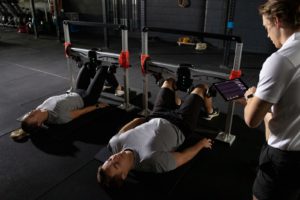News
RESEARCH SUMMARY: Predicting ankle injury when considered with higher body mass in US special forces (Eagle et al., 2019)
Original research title: Bilateral strength asymmetries and unilateral strength imbalance: predicting ankle injury when considered with higher body mass in US special forces
Authors: Eagle S, Kessels M, Johnson C, Nijst B, Lovalekar M, Krajewski K, Flanagan S, Nindl B, and Connaboy C.
Year: 2019
Purpose
Ankle injuries are very common and costly in Special Forces populations. Previous studies have been unable to consistently identify risk factors that can be used to flag individuals at higher-than-normal risk of sustaining an ankle injury. Early identification of high-risk individuals is crucial for practitioners as they can modify exercise prescription to reduce injury risk.
The purpose of the study was to analyze the anthropometric, physiological, and strength metrics that can be used to predict ankle injury risk over one year.
Methods
Prospective cohort study with 140 U.S. Special forces soldiers. All soldiers were assessed at baseline and followed over time to determine if any metrics could be used to predict ankle injury risk.
Baseline measurements included:
• Age, height, body mass, fat-free mass, aerobic capacity, anaerobic capacity, and body fat percentage.
• Ankle eversion and inversion isometric strength asymmetry.
Key findings
- 14 of the 140 soldiers sustained an ankle injury 1 year after baseline testing.
- Of the measured baseline metrics, strength asymmetry contributed to predicting ankle injury in a multivariate model using body mass.
VALD’s solution
VALD’s ForceFrame isometric strength testing system provides a reliable way to measure strength asymmetries across a range of muscle groups. The system has demonstrated reliability when used to assess ankle strength and can be used in a military population to measure ankle eversion and inversion strength asymmetries. Quantify asymmetries in your population and easily flag high-risk individuals who require specialized physical training with VALD.
See VALD’s Ankle Inversion/Eversion test protocol here.
For the full study, see here.
Would you like to learn more about VALD Tactical Systems?
Contact us at info@valdtactical.com or fill in the contact form here.
RESEARCH SUMMARY: Influence of age on recovery from worksite resistance exercise in career firefighters (Trivisonno et al, 2021)
Original research title: The influence of age on the recovery from worksite resistance exercise in career firefighters
Authors: Trivisonno, A., Laffan, M., Giuliani, H., Mota, J., Gerstner, G., Smith-Ryan, A., Ryan, E.
Year: 2021
Purpose
Over 60,000 firefighters sustain an injury every year in the US and the largest percent of these are musculoskeletal strains and sprains. Given these injuries result in many worker’s compensation claims and reduced workforce capability, strategies to mitigate injury risk are critical.
Exercise is known to help protect against injuries yet over 75% of firefighters do not meet the minimum physical activity recommendations. Part of the problem is finding time within a shift to complete physical activity and ensuring soreness and fatigue from physical training does not influence job performance.
Researchers wanted to determine if a session of resistance training impairs short-term neuromuscular function in firefighters across younger (18-30 years) and older (45-60 years) age groups.
Methods
Participants were tested pre resistance training and 24, 48, and 72 hours post training. The suite of tests included questionnaires for work related fatigue and muscle soreness, countermovement jump to measure jump height and velocity, and upper and lower body isometric strength tests. Resistance training included a circuit-style session of multi-joint movements that engaged major muscles groups. Each exercise had weights at 80% of the predicted one repetition maximum.
All outcome metrics were compared statistically over the four time periods to determine the effect of resistance exercise on neuromuscular function.
Key findings
• Countermovement jump (CMJ) height and velocity decreased significantly pre- to 24 hours post-testing
• Upper and lower body peak force decreased 5-15% from pre-to 24-, 48-, and 72-hours post-testing.
• Younger firefighters had better CMJ performance than older firefighters, however, isometric strength was the same.
VALD’s solution
VALD provides a single technology solution to monitor neuromuscular fatigue in first responders both from their physical training and also arduous shift work. Take the guesswork out of repeat measurement by using technology with proven reliability.
Use ForceDecks to quickly assess to quickly assess CMJ performance pre- and post-shift in firefighters with the important metrics of jump height and velocity instantly available on the testing device and in the cloud. Pair the CMJ with the Isometric Mid-thigh Pull test to quantify lower body strength changes.
Combine ForceDecks measurements with the ForceFrame to quantify upper body strength specific to the muscle group of interest. ForceFrame enables testing of over 35 different muscle groups, including shoulder flexion/extension, abduction/adduction, and internal/external rotation.
Access VALD Hub to manage your personnel and visualize test data in a central location. With VALD Hub, you can easily quantify changes over time and track the progress of first responders. Easily compare older and younger firefighters to see if age gaps in strength and physical function exist in your cohort.
For the full study, see here.
Would you like to learn more about VALD Tactical Systems?
Contact us at info@valdtactical.com or fill in the contact form here.
RESEARCH SUMMARY: Musculoskeletal, Biomechanical, and Physiological Gender differences in the US Military (Allison et al., 2015)
Original research title: Musculoskeletal, Biomechanical, and Physiological Gender differences in the US Military
Authors: Allison, K., Keenan, KA., Sell, TC., Abt, JP., Nagai, T., Deluzio, J., McGrail, M., & Lephart, SM.
Year: 2015
Purpose
Physical strength and movement quality gender discrepancies exist and can influence the physical suitability of an individual for different job roles. It is well understood that individuals not physically suitable to perform their job are at an increased risk of injury compared to those who are physically suitable. Quantifying these discrepancies using objective data helps practitioners implement physical training programs to bridge any gaps in physical strength and movement quality.
The aim of this study was to quantify physiological and biomechanical differences between men and women across a range of assessments to aid in creating gender-specific physical training programs.
Methods
406 101st Airborne Division soldiers (348 Male; 58 Female) were assessed for flexibility, isometric strength, balance, and lower body biomechanics. The results were compared between genders statistically using independent t-tests. Laboratory-based technology was used to capture shoulder, hip, knee, and ankle range of motion, strength, and power production across a range of isometric and dynamic movements.
The selected assessments had the sensitivity to detect differences between genders.
Key findings
- Female soldiers had lower absolute muscle strength and power compared to male soldiers, and impaired movement biomechanics during the drop jump test.
- Screening personnel with objective data is necessary to flag the highest risk personnel so tailored training programs can be prescribed irrespective of gender.
- Implementing tailored physical training programs for women to increase muscle strength and power should improve their job readiness and reduce the risk of musculoskeletal injury.
Consequently, doing so can help improve organization readiness by reducing the amount of personnel medically unfit for deployment and promote female participation across all job roles.
VALD’s solution
VALD Systems can be used to implement screening of personnel quickly and with the minimal user experience of the technology. By integrating VALD Systems with VALD Hub, the workflow to mass test over 400 personnel becomes simple. Access VALD Hub to manage personnel and visualize test data in a central location. With VALD Hub, practitioners and tactical professionals can easily quantify differences between men and women and use the results to inform physical training programs.
ForceFrame Strength Testing System can be used test the isometric strength and imbalances of personnel for almost all muscle groups in over 35 different positions. Easily configure the ForceFrame for your testing needs and have confidence that objective data is being recorded reliably.
ForceDecks Dual Force Plate System can be used to measure vertical ground reaction forces during a drop landing test and view key metrics instantly. Expand the test types to include countermovement jump and isometric mid-thigh pull to quickly quantify neuromuscular fatigue and full-body strength. Rely on the consistency of ForceDecks technology to monitor changes over time so the effectiveness of prescribed programming can be evaluated.
HumanTrak can be used to measure hip and knee joint angles reliably and quickly during drop landing, single-leg squat, and overhead squat tests. Instantly quantify joint angles at key moments during the test (e.g., ground contact during drop jump) and use the information to inform personnel about correct movement techniques. Track changes over time to evaluate if personnel are improving and adjust your programming as required.
For the full study, see here.
Would you like to learn more about VALD Tactical Systems?
Contact us at info@valdtactical.com or fill in the contact form here.













